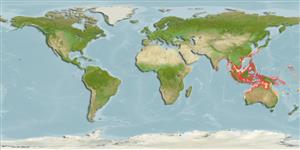Common names from other countries
ກຸ່ມປາກະດູກອ່ອນ (ເຊັ່ນ: ປາສະຫລາມ, ປາຜາໄລ) (sharks and rays) >
Myliobatiformes (Stingrays) >
Dasyatidae (Stingrays) > Urogymninae
Etymology: More on author: Gray.
Issue
Distribution to check.
Environment: milieu / climate zone / depth range / distribution range
ນິເວດວິທະຍາ
ສັດທະເລ; ນ້ຳກ່ອຍ ອາໄສຢູ່ໃກ້ໜ້າດິນໃຕ້ພື້ນທ້ອງນ້ຳ; ລະດັບຄວາມເລິກ ? - 50 m (Ref. 5578). Tropical
Indo-West Pacific: Oman to Indonesia; north to Taiwan.
Length at first maturity / ຂະໜາດ / ນ້ຳໜັກ / Age
Maturity: Lm ?, range 64 - ? cm
Max length : 200 cm TL ຕົວຜູ້/ບໍ່ມີເພດ; (Ref. 9840)
Likely confined to the inner continental shelf (Ref. 9840), over sandy and mud bottoms (Ref. 30573). Recorded from coastal waters and river mouths (Ref. 45255). Feeds on bottom crustaceans including shrimp, crabs and small lobsters (Ref. 5578). Ovoviviparous (Ref. 50449). Important food fish, the skin and flesh are dried or used to produce leather for purses and bags (Ref. 9840). Caught in very large quantities in the demersal tangle net, bottom trawl and trammel net fisheries. Utilized for its meat, skin (high value) and cartilage (Ref. 58048). It is parasitised on the dorsal skin surface by the monogeneans Dendromonocotyle citrosa, D. colorni, D. ukuthena (Ref. 124058) and D. lotteri (Ref. 124051).
Exhibit ovoviparity (aplacental viviparity), with embryos feeding initially on yolk, then receiving additional nourishment from the mother by indirect absorption of uterine fluid enriched with mucus, fat or protein through specialised structures (Ref. 50449). Distinct pairing with embrace (Ref. 205). Bears 2 young in summer (Ref. 5578). Gives birth to litters of 1-4 pups; born at 18-21 cm WD (Ref.58048).
Last, P.R., W.T. White, M.R. de Carvalho, B. Séret, M.F.W. Stehmann and G.J.P. Naylor, 2016. Rays of the world. CSIRO Publishing, Comstock Publishing Associates. i-ix + 1-790. (Ref. 114953)
IUCN Red List Status (Ref. 130435)
CITES (Ref. 128078)
Not Evaluated
Threat to humans
Harmless
Human uses
ການປະມົງ: ເປັນສີນຄ້າ; ຊະນິດປາທີ່ຖືກນຳໃຊ້ເຂົ້າໃນການຫາເພື່ອເປັນເກມກິລາ: ແມ່ນ; ຕູ້ປາ: ເປັນສີນຄ້າ
ເຄື່ອງມື
Special reports
Download XML
ແຫຼ່ງອີນເຕີເນັດ
Estimates based on models
Preferred temperature (Ref.
115969): 24.7 - 29.1, mean 28.4 (based on 1116 cells).
Phylogenetic diversity index (Ref.
82804): PD
50 = 0.5078 [Uniqueness, from 0.5 = low to 2.0 = high].
Bayesian length-weight: a=0.01622 (0.00606 - 0.04338), b=3.00 (2.77 - 3.23), in cm Total Length, based on LWR estimates for this (Sub)family-body shape (Ref.
93245).
ຊັ້ນເຂດຮ້ອນ (Ref.
69278): 3.7 ±0.55 se; based on food items.
ຄວາມຢືດຢຸ່ນ (Ref.
120179): ຕຳ່ຫຼາຍ, ປະຊາກອນຕຳ່ສຸດທີ່ໃຊ້ເວລາສອງເທົ່າຫຼາຍກວ່າ 14 ປີ (Fec=2).
Fishing Vulnerability (Ref.
59153): Very high vulnerability (90 of 100).
Climate Vulnerability (Ref.
125649): Moderate to high vulnerability (50 of 100).
